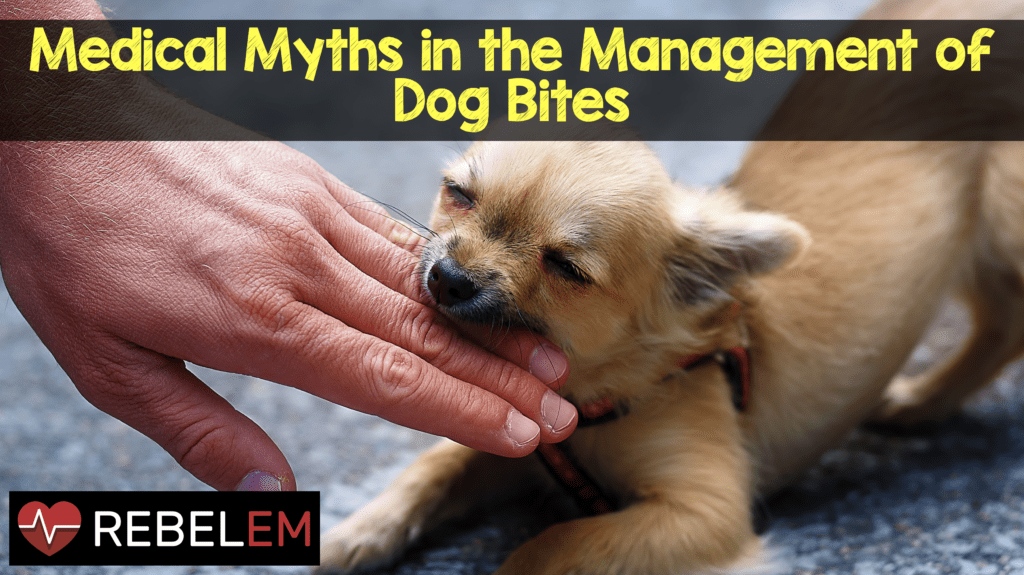
 Animal bites are a common cause of injury in the United States. About 4.5 million Americans/year (5% of all traumatic wounds in the ED) will sustain a bite injury. Dog bites compromise a majority of these wounds. The classic teaching is that dog bites should not be closed primarily and they should all be prophylactically treated with antibiotics. When dog bites become infected, Pasteurella species, specifically P. canis, are the most common pathogens. Amoxicillin-clavulanate (AKA “dog-mentin”) is the antibiotic of choice. It’s also important to keep in mind that Emergency Department repaired lacerations (not just dog bites but all comers) have a 3-7% infection rate. As usual, the dogma (pun intended) is based on minimal if any evidence. Additionally, there are some recent articles that are relevant to the discussion that should be discussed.
Animal bites are a common cause of injury in the United States. About 4.5 million Americans/year (5% of all traumatic wounds in the ED) will sustain a bite injury. Dog bites compromise a majority of these wounds. The classic teaching is that dog bites should not be closed primarily and they should all be prophylactically treated with antibiotics. When dog bites become infected, Pasteurella species, specifically P. canis, are the most common pathogens. Amoxicillin-clavulanate (AKA “dog-mentin”) is the antibiotic of choice. It’s also important to keep in mind that Emergency Department repaired lacerations (not just dog bites but all comers) have a 3-7% infection rate. As usual, the dogma (pun intended) is based on minimal if any evidence. Additionally, there are some recent articles that are relevant to the discussion that should be discussed.
Dogma #1 – Dog bites should not be primarily closed
Article #1 – Chen E et al. Primary Closure of Mammalian Bites. Acad EM 2000; 7(2): 157-162. PubMed ID: 10691074
Details
- A total of 145 mammalian bites were included and all were closed primarily.
- 88/145 were dog bites and 5 of these (5.7%) became infected.
- 81% of patients were discharged on oral antibiotics and amoxicillin-clavulanate was the most commonly used antibiotic.
Commentary: Carefully selected mammalian bite wounds can be sutured with approximately a 6% rate of infection. The infection rate is within the usual infection rate for any wounds sutured in the Emergency Department. The risk of infection may be acceptable where cosmesis is a primary concern. This study was not randomized and there was no comparison group. The researchers did find that the rate of infection was no different between those who were and were not given antibiotic prophylaxis.
Artice #2 – Paschos NK et al. Primary closure versus non-closure of dog bite wounds. A randomised controlled trial. Injury 2014 45(1): 237-40. PubMed ID: 23916901
Details
- 168 dog bite patients randomized to primary closure vs. healing by secondary intent
- Wound cleaning – high pressure irrigation and providine iodine
- All patients got amoxicillin-clavulanate for prophylaxis
- Overall infection rate – 8.3%. No statistically significant difference between groups (9.7 vs 6.9%)
- Cosmetic appearance of primarily closed wounds was better
- If wound closed: < 8 hours – 4.5% infection rate
- > 8 hours – 22.2% infection rate
- Head and facial wounds had lower infection rates overall

Commentary: Based on this study, it seems reasonable to close any dog bite < 8 hours old regardless of location as it improves cosmetic outcome with a nonsignificant change in the infection rate. Although this study doesn’t give us information about patient satisfaction, my guess is that patients would be happier to have their lacerations closed.
Throughout my training, I was taught that if the bite was on the face, close it so that the cosmetic outcome will be better. If it’s anywhere else, don’t bother. However, this doesn’t make sense in a number of ways. If infection is an issue, an infected wound on the face is going to have a terrible outcome cosmetically. Additionally, I’d be worried about leaving a wound open and exposed to “prevent” infection.
The issue is far more complex. Each patient and wound is unique. How big is the laceration? How much tissue loss is there? How much crush injury to the tissue is present? How long ago did the laceration occur? What are the patient’s comorbid conditions? All of these issues need to be considered when we contemplate management.
Dogma #2 – All dog bites should be prophylaxed with antibiotics
Article – Medeiros IM, Saconato H. Antibiotic prophylaxis for mammalian bites (Review). Cochrane Database of Systematic Reviews 2008 (3); PubMed ID: 11406003
Details
- Meta-analysis of 6 studies on dog bites with prophylactic antibiotics vs. placebo
- No evidence that prophylactic antibiotics for dog/cat bites reduces infection rate
- There is limited evidence that antibiotics reduce the rate of infection in bites to the hand but needs larger studies for confirmation.

Commentary
As usual, the Cochrane review finds no benefit to the studied intervention. The question, though, is can we change practice based on this? Yes . . . and no. I think there’s ample evidence that if the dog/cat bite is to any part of the body other than hand, antibiotic prophylaxis is unnecessary in the majority of cases. However, with little data on the hand bites, continued prophylaxis would seem a reasonable path.
There are a number of caveats that should be considered. As mentioned above, we shouldn’t adopt a hard, unbendable stance on any of these interventions. The individual patient and wound should be considered. I would still prophylaxis a 4 cm dog bite with significant crush and tissue loss in a 55-year-old diabetic. Also, the available studies looking at primary closure generally provided antibiotic prophylaxis so we can’t extrapolate the Cochrane review to those patients whose lacerations we repair.

Clinical Take Home Points
- It appears safe to close all dog bites regardless of location as long as they are < 8 hours old, and copious high-pressure irrigation
- In patients with non-hand location dog bites, antibiotics are not needed if we leave the wound open for secondary repair.
- If we primarily close the wound, we should continue to provide antibiotic prophylaxis until someone performs a randomized trial of primary closure +/- antibiotic prophylaxis.
References:
- Chen E et al. Primary Closure of Mammalian Bites. Acad EM 2000; 7(2): 157- 162. PubMed ID: 10691074
- Paschos NK et al. Primary closure versus non-closure of dog bite wounds. A radomised controlled trial. Injury 2014 45(1): 237-40. PubMed ID: 23916901
- Medeiros IM, Saconato H. Antibiotic prophylaxis for mammalian bite (Review). Cochrane Database of Systematic Reviews 2008 (3); PubMed ID: 11406003
The post Medical Myths in the Management of Dog Bites appeared first on REBEL EM - Emergency Medicine Blog.
